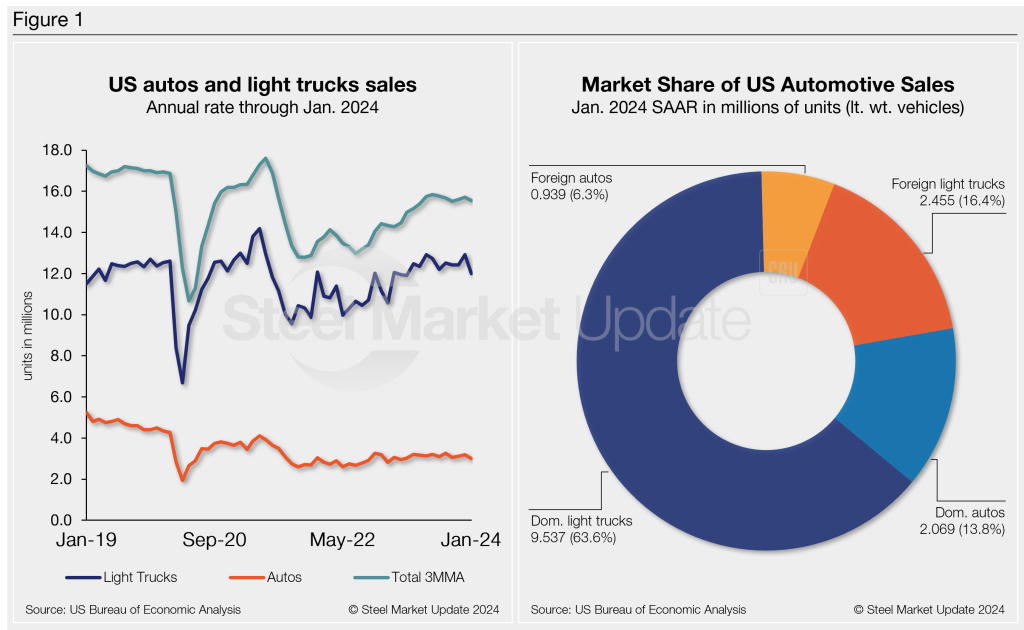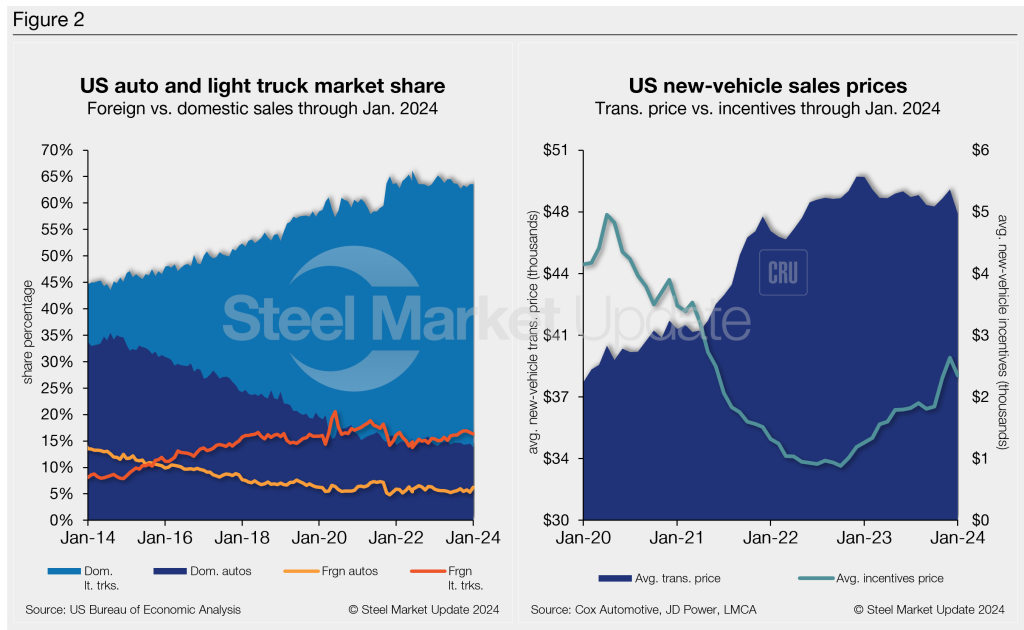Features

US light-vehicle sales fall in January, still ahead y/y
Written by David Schollaert
February 21, 2024
US light-vehicle (LV) sales rose to an unadjusted 1.08 million units in January, up 2.8% vs. year-ago levels, the US Bureau of Economic Analysis (BEA) reported. Despite the year-on-year (y/y) boost, domestic LV sales were down 5.6% month on month (m/m).
On an annualized basis, LV sales were 15 million units in January, down from 16.1 million units the month prior, and below the consensus forecast which called for a more modest decline to 15.7 million units.
Auto sales were likely impacted by a holiday splurge hangover and several winter storms across the Midwest and Northeast. High-priced inventory and higher financing rates continued to weigh on sales, though a recovery in incentive spending helped to support sales. And while production levels are roughly back at pre-pandemic levels, the average transaction price only fell by 2.4% in 2023.
The average daily selling rate (DSR) was 43,042 – calculated over 25 days – down from January 2023’s 43,622 daily rate. Passenger vehicle sales increased 1.4% y/y while sales of light trucks moved higher by 3.1% over the same period. Light trucks accounted for 80% of last month’s sales, roughly the same as its share of sales in January 2023.
Below in Figure 1 is the long-term picture of sales of autos and lightweight trucks in the US from 2019 through January 2024. Additionally, it includes the market share sales breakdown of last month’s 15 million vehicles at a seasonally adjusted annual rate.

The new-vehicle average transaction price (ATP) was $47,401 in January, down 2.8% from December. Last month’s ATP was also 4.2% (-$2,067) below the year-ago period, according to Cox Automotive data.
Incentives decreased for the first time in four months. Last month’s incentives were $2,346, down 10.9% from December’s 31-month high of $2,633. With the m/m decrease, incentives are nearly 5% of the average transaction price. Incentives are up 86%, or $1,086, y/y.
In January, the annualized selling rate of light trucks was 11.991 million units, down 7.2% vs. the prior month and down 0.5% y/y. Annualized auto selling rates saw similar dynamics, down 5.8% and 1.5% in the same comparisons.
Figure 2 details the US auto and light-truck market share since 2013 and the divergence between average transaction prices and incentives in the US market since 2020.

Editor’s Note: This report is based on data from the US Bureau of Economic Analysis (BEA), LMC Automotive, JD Power, and Cox Automotive for automotive sales in the US, Canada, and Mexico. Specifically, the report describes light vehicle sales in the US.

David Schollaert
Read more from David SchollaertLatest in Features

Final Thoughts
I’m not sure what I can write today that won’t be old news after April 2. The Trump administration has dubbed Wednesday “Liberation Day.” Since it’s mostly about tariffs, let’s just call it “Tariff Day.” Or maybe we should call it “Tariff Week” – since tariffs typically dominate the news cycle in the first week […]

Price on Trade: Auto tariffs, auto parts, and Hyundai – a world of rapid changes
Trump's new auto tariffs will apply to passenger vehicles (including sedans, sport utility vehicles, crossover utility vehicles, minivans, and cargo vans), light trucks, and certain automobile parts (including engines and engine parts, transmissions and powertrain parts, and electrical components).

SMU Steel Summit 2025: Will we see you there?
Anticipation leading up to SMU’s Steel Summit 2025 is already heating up after last year’s record-setting attendance!

Week in Review: March 23-28
The constant flow of information we all receive can be a little overwhelming, but SMU is here to help with a snapshot of the week.

CRU: Canacero urges Mexico-US partnership to fend off Asian steel imports
Victor Cairo, head of Mexico’s steel sector body Canacero and CEO of ArcelorMittal Mexico, says he is confident negotiations between the Mexican and US governments planned for April 2 will lead to the creation of a regional block to substitute imports, especially from Asia.
